
Marchantiales is an order of thallose liverworts that includes species like Marchantia polymorpha, a widespread plant often found beside rivers, and Lunularia cruciata, a common and often troublesome weed in moist, temperate gardens and greenhouses.

Lunularia cruciata, the crescent-cup liverwort, is a liverwort of the order Marchantiales, and the only species in the genus Lunularia and family Lunulariaceae. The name, from Latin luna, moon, refers to the moon-shaped gemma cups.
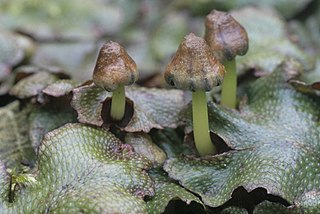
Conocephalum is a genus of complex thalloid liverworts in the order Marchantiales and is the only extant genus in the family Conocephalaceae. Some species of Conocephalum are assigned to the Conocephalum conicum complex, which includes several cryptic species. Conocephalum species are large liverworts with distinct patterns on the upper thallus, giving the appearance of snakeskin. The species Conocephalum conicum is named for its cone-shaped reproductive structures, called archegoniophores. Common names include snakeskin liverwort, great scented liverwort and cat-tongue liverwort.

Sabinene is a natural bicyclic monoterpene with the molecular formula C10H16. It is isolated from the essential oils of a variety of plants including Marjoram, holm oak (Quercus ilex) and Norway spruce (Picea abies). It has a strained ring system with a cyclopentane ring fused to a cyclopropane ring.
Monoicy is a sexual system in haploid plants where both sperm and eggs are produced on the same gametophyte, in contrast with dioicy, where each gametophyte produces only sperm or eggs but never both. Both monoicous and dioicous gametophytes produce gametes in gametangia by mitosis rather than meiosis, so that sperm and eggs are genetically identical with their parent gametophyte.

The fraternal myotis is a species of vesper bat native to East Asia.

Lycogala epidendrum, commonly known as wolf's milk or groening's slime, is a cosmopolitan species of myxogastrid amoeba which is often mistaken for a fungus. The aethalia, or fruiting bodies, occur either scattered or in groups on damp rotten wood, especially on large logs, from June to November. These aethalia are small, pink to brown cushion-like blobs. They may ooze a pink "paste" if the outer wall is broken before maturity. When mature, the colour tends to become more brownish. When not fruiting, single celled individuals move about as very small, red amoeba-like organisms called plasmodia, masses of protoplasm that engulf bacteria, as well as fungal and plant spores, protozoa, and particles of non-living organic matter through phagocytosis.
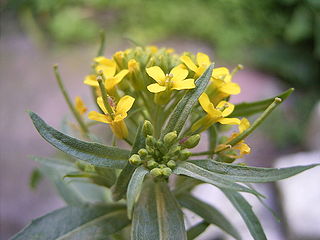
Erysimum cheiranthoides, the treacle-mustard,wormseed wallflower, or wormseed mustard is a species of Erysimum native to most of central and northern Europe and northern and central Asia. Like other Erysimum species, E. cheiranthoides accumulates two major classes of defensive chemicals, glucosinolates and cardiac glycosides.
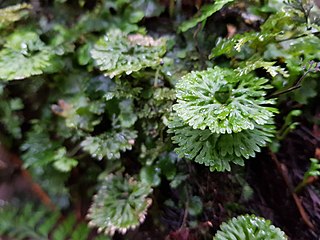
Hymenophyton flabellatum is a species of the order Pallaviciniales (liverworts), one of perhaps several species in the genus Hymenophyton. It is a dendroid thalloid liverwort belongs to the family Hymenophytaceae and is commonly known as Fan liverwort. It is found in New Zealand, Chile, and common in wet forests of Australia and Tasmania. Hymenophyton flabellatum closely resembles with small filmy fern, Hymenophyllum and can be confused with the liverwort, Symphyogyna hymenophyllum.

Reboulia hemisphaerica, the hemisphaeric liverwort or small mushroom-headed liverwort, is the only species of liverwort in the genus Reboulia.

Dihydrostilbenoids (bibenzyls) are natural phenols formed from the dihydrostilbene (bibenzyl) backbone.

Lunularic acid is a dihydrostilbenoid found in the liverwort Lunularia cruciata and in the roots of Hydrangea macrophylla.

Conocephalum conicum, also known as the great scented liverwort or snakeskin liverwort, is a liverwort species in the genus Conocephalum. C. conicum is part of the Conocephalum conicum complex, which includes several cryptic species. The name C. conicum refers to the cone-shaped archegoniaphore, which bear sporangia.
Lunularic acid decarboxylase is an enzyme that converts lunularic acid into lunularin.

Marchantia berteroana is a liverwort species in the genus Marchantia.
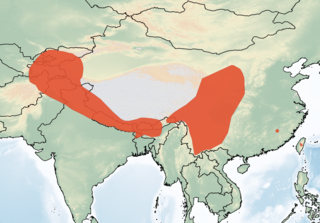
The eastern barbastelle or Asian barbastelle is a species of vesper bat found throughout much of Asia, from Afghanistan to Taiwan.

Conocephalum salebrosum, commonly known as snakewort, is a species of liverwort, a non-vascular land plant, with a broad, holarctic distribution. It is also known as snakeskin liverwort, cat-tongue liverwort, mushroom-headed liverwort, and great scented liverwort.
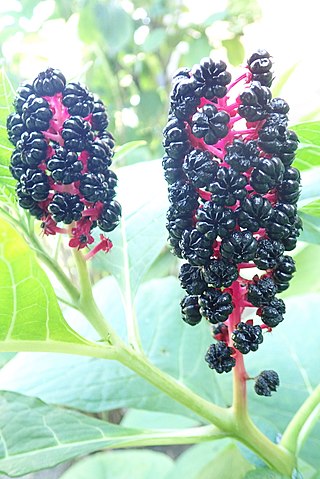
Phytolacca acinosa, the Indian pokeweed, is a species of flowering plant in the family Phytolaccaceae. It is native to temperate eastern Asia; the Himalayas, most of China, Vietnam to Japan, and has been widely introduced to Europe. The species was originally described by William Roxburgh in 1814.

The oil bodies of liverworts, occasionally dubbed “complex” for distinction, are unique organelles exclusive to the Marchantiophyta. They are markedly different from the oil bodies found in algae and other plants in that they are membrane-bound, and are not associated with food storage. The organelles are variable and present in an estimated 90% of liverwort species, often proving taxonomically relevant. As a whole, the formation and function of the organelles are poorly understood. Complex oil bodies are recognized as sites of isoprenoid biosynthesis and essential oil accumulation, and have been implicated with anti-herbivory, desiccation tolerance, and photo-protection.
The centipedes or Chilopoda are divided into the following orders.
















